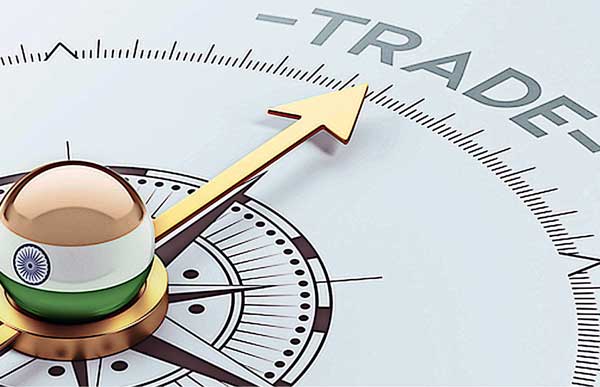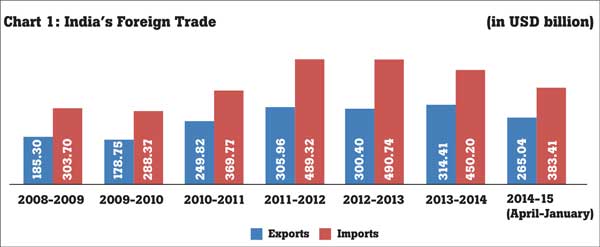28 Oct 2016 - {{hitsCtrl.values.hits}}

The foreign trade policy (FTP) of India is a well defined document in operation which directs the  country’s policy on trade for the time period of 2015 to 2020. It is published by the Director General of Foreign Trade through a gazette notification.
country’s policy on trade for the time period of 2015 to 2020. It is published by the Director General of Foreign Trade through a gazette notification.
The vision of the FTP of India is to make India an important contributor to world trade by 2020 and to take the leadership in the international trade arena. The expectation of the government is to raise Indian exports from US $ 460 billion to approximately US $ 900 billion by 2020.
In today’s context, foreign trade is playing a key role in any economy and in an increasingly globalized scenario, it is so important for India as well. The high current account deficit is pushing India to have policies promoting more exports and be well focused on imports and as a matter of fact, the FTP has a direct connection to the domestic economic policies of India. So the FTP is considered to be well merged to the overall economic policy of India. The recent strategic measures taken by India to energize the economy, such as ‘Make In India’, ‘Digital India’ and ‘Skills India’ have shown positive results with better export prospects.
Whilst making a path for export expansion, India is focused on addressing the key internal issues such as infrastructure bottlenecks, high transaction costs, complex procedures, constraints in manufacturing and inadequate diversification in the services exports.

Product approach
India is always keen in promoting exports through a line of products which creates a sound local manufacturing base and generating employment opportunities in the economy through identified products such as engineering products, electronics, pharmaceuticals, medical devices/equipment, light manufacturing sectors: leather products and textiles, gems and jewellery sector, natural resource-based products, agricultural products, plantation products, defence products, etc. India is further looking into the services exports sector and organic agro products to be more established. On overall basis, the Indian trade policy would be more committed to make its products to be of world class, branded and with a serious export promotion strategy.
The Indian FTP is clearly mentioning the fact that the Indian products are of much disadvantageous situation in participating global or regional value chains due to the infrastructure and administration issues that should be sorted out earnestly. Whilst developing entrepreneurship and manufacturing capacity locally, India is more concerned about the non-tariff measures operating in many countries and addresses them effectively in order to improve the export market opportunities.
Import assessment
As identified in the FTP, India needs to carefully asses the import requirements of the country with a view of rationalizing it and to fit into the domestic economic development strategy. The Commerce Department has recognized 21 stakeholder government institutions in the country, which will probe importing requirements with the intension of producing those products cost effectively in India.
Impact of trade agreements
The three major trade agreements namely, the Trans Pacific Partnership (TPP), Trans Atlantic Trade and Investment Partnership (TTIP) and Regional Comprehensive Economic Partnership (RECP), are making a serious impact to the global economy. The fact that India is not directly involved in the TPP and TTIP makes an impact on the Indian economy in the global space. It is noteworthy that there are 398 regional trade agreements in force as of January 2015 in the globe. India has actively engaged in many such trade agreements by ratifying 11 free trade agreements (FTA), five Limited Prudential Trade Agreements and negotiating 17 more FTAs, as indicated in the FTP of India.
Services sector of India with high potential
The services sector is contributing approximately 58 percent of the gross domestic product (GDP) of India and 28 percent of the employment and attracts trade and foreign direct investments (FDIs) in great numbers. Likewise, the share of services exports of India is more than 3.3 percent of global services exports.
Information technology and information technology-enabled services (IT and ITES) are the single largest export of services in India, where 80 percent of the opportunities are from the US and 20 percent coming from European Union (EU). In the backdrop, it is imperative that India should look at other market destinations and product diversifications. There are limitations in the services market openings in Japan, Korea and China due to the existing language barriers.
Special Economic Zones
As per the FTP of India, Special Economic Zones (SEZ) was enacted in 2005 and became operational in 2006 with the following objectives: promotion of exports of goods and services; promotion of investment from domestic and foreign sources; creation of employment opportunities; and development of infrastructure facilities. The SEZ concept has given positive results to the economy of India where many subsequent improvements took place around the said operation.
Trade promotion and infrastructure
As identified in the FTP, India is working systematically with a vision to reach the maximum possible trade promotion through creating world-class products and reaching Brand India aspirations through activities such as development of a standard brand kit, revamping of websites of trade bodies (export promotion councils), engagement with global media, reorienting ‘The India Shows’, having Brand Manual for exhibitors and encouraging broader sectorial campaigns, which are noteworthy.
The Institutional Mechanisms to Promote Trade - Market Access Imitative (MAI) and Market Development Assistance (MDA) and many other such schemes are available for trade promotions and these efforts are taking place unceasingly for a longer period offering benefits to the respective business sectors. Organisation of exhibitions, buyer-seller meets, seminars, conferences and conventions, supporting participation in established exhibitions are generally covered under the MAI, which is operational from 2003 onwards generating constructive outcomes, whilst the MDA is looking after the financial assistance needed for export promotions.
Focus on South Asia
As per the FTP statement, India is paying special attention to her immediate neighbours in south Asia with the view of building regional value chains in different sectors such as textiles, engineering goods, chemicals, pharmaceuticals, auto components, plastic and leather products, etc. The expectation is to create an integrated trade channel to South East Asia and Central Asia. As a part of the action plan, India is working on trade integration activity to enable the Indian private sector to set up manufacturing hubs in the region of Cambodia, Laos, Myanmar and Vietnam. Bangladesh is the largest trading partner of India among the South Asian Association for Regional Cooperation (SAARC) countries and followed by Sri Lanka, Nepal and Pakistan. India is already providing tariff benefits to the least developed countries in the SAARC region with the intention of developing those economies and minimizing trade deficits with India.
The FTP statement of India utters that the bilateral FTA signed with Sri Lanka has opened up significant trade access to Sri Lanka and it is leading to a fair degree of integration of the economies in the region. Subsequently, India-Sri Lanka negotiated the Comprehensive Economic Partnership Agreement (CEPA), which was not materialized. Taking relationships further, the two countries are now negotiating the Economic Technology Cooperation Agreement (ETCA).
United States and EU
The US being a top trading partner of India and the recovery of the US economy is giving optimistic impact for Indian economy. The export sectors such as textile, agriculture, leather and gems and jewellery have become promising in generating employment opportunities in the local space. Additionally, India is counting on sending high-skilled professionals to the US and also promoting home as a destination for investments.
The EU is also considered to be a top trading partner and India is concerned in ironing out sanitary, phytosanitary, quotas and tariffs-related matters with the view of expanding exports into the EU. The information technology services-related opportunities are also much awaited by India but facing difficulties with the EU regulations on data security aspects. Furthermore, new market opportunities in the areas of defence equipment, medical equipment, construction material, processed foods and project exports are also being explored by India very positively.
China being an important trading partner
China being a large and strong economy at the door step, India is having a wide-ranging approach for China which includes trade, investment and economic cooperation aspects. India is very closely working on sorting out market access issues such as non-tariff barriers for Indian products, i.e., pharmaceuticals and agro commodities; furthermore to gain market access for its IT services, tourism and film and entertainment industries and to boost India’s manufacturing capacities by attracting Chinese investments. At the same time, India is taking many efforts to strengthen trade relationship with Japan and Korea as well.
Approach for African Continent
In addition to the investment and trade relationships, India is greatly favourable in creating space for Indian companies to play on capacity development, technical assistance, offering healthcare and education services, manufacturing, mining, textiles, fast-moving consumer goods (FMCG), infrastructure development and construction. Furthermore, India is positively considering having trade agreements with African regional groupings.
The Indian FTP document states that India is working on two more FTAs with Israel and the Gulf Cooperation Council comprised of six countries. The FTP is an evolving policy document, which will be reviewed and evaluated at regular intervals. The government of India is responsible for the foreign trade policy but much of the activities take place in the states, where the state government could play a crucial role in promoting exports and rationalizing imports, so the necessary steps have been taken to address such a situation.
Reference: Foreign Trade Policy (FTP) Statement of India 2015-2020
(Bandula Dissanayake is the Secretary General/CEO of the National Chamber of Commerce of Sri Lanka)
10 Jan 2025 28 minute ago
10 Jan 2025 33 minute ago
10 Jan 2025 2 hours ago
10 Jan 2025 2 hours ago
10 Jan 2025 2 hours ago